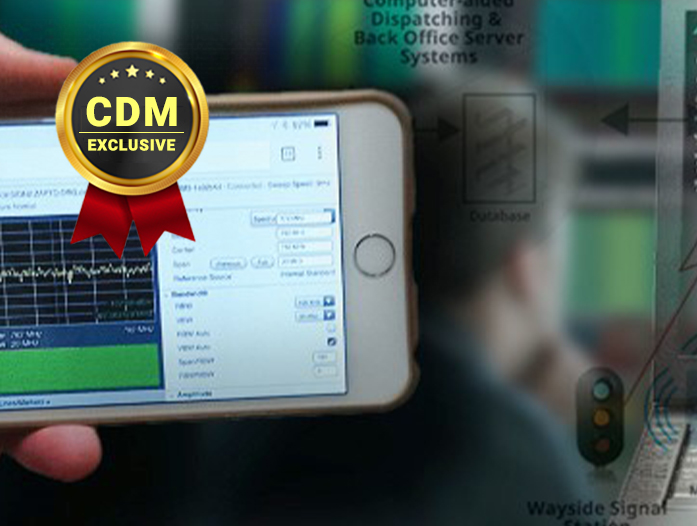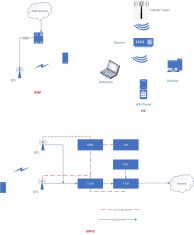- What to Do If You Book a Hotel or Airbnb and It Turns Out to Be a Scam | McAfee Blog
- Cómo evitar la fuga de cerebros en TI
- Is ChatGPT Plus still worth $20 when the free version packs so many premium features?
- How this 'FinOps for AI' certification can help you tackle surging AI costs
- ChatGPT can record, transcribe, and analyze your meetings now
Introduction to Remote Spectrum Monitoring

Spectrum Monitoring for Critical Infrastructure
By Brandon Malatest, Per Vices Corporation
As wireless communications break its expansion banks, the need for robust networks relatively free of interference continues to grow. Presence of illegal or unlicensed signals interfering with the needed transmissions degrades this capacity. The discovery and removal of these sources of interference poses a significant challenge as signals can be periodic or present at different frequencies over time. It is therefore critical for the spectral bands, in which infrastructure systems such as airports and mobile networks operate, to remain uninterrupted.
This article discusses the use of Software-Defined Radio (SDR) in spectrum monitoring to identify signals interference in Air Traffic Control and Mobile Network infrastructures. With some SDRs equipped with multiple-input multiple-output (MIMO) which have wide tuning ranges and high instantaneous bandwidths, it is possible to prevent signal interferences in these critical infrastructures.
What is spectrum monitoring?
Spectrum monitoring is the process of detecting, analysing, and measuring electromagnetic emissions over a wide range of frequencies. Spectrum monitoring identifies potential sources of interference, optimizes communication systems, protects against unauthorized use of the electromagnetic spectrum, and many other functions including; characterizing RF emissions, determining spectrum availability, managing regulated spectrum and detecting illegal transmissions.
Why spectrum monitoring?
Spectrum monitoring has different applications depending on the usage. In licensed band services, spectrum monitoring is used to protect licensed users and free bands from illegal users. Spectrum monitoring shows the actual use of the spectrum and ensures its efficiency. This ensures users comply with national and international rules.
Spectrum monitoring in Airport infrastructure
The International Telecommunication Union (ITU) dictates the allocation of radio spectrum and use of a frequency to a specific service. There are several ITU allocations for communications navigation and surveillance in the Air Traffic Control sector.
The air-to-ground radio spectrum includes air traffic control voice communications, secondary surveillance radar (SSR) and datalink communications. The common frequency bands used include Non-Directional Beacons (NBDs), HF Communications, VHF omnidirectional range (VOR), Instrument Landing System (ILS) and ILS glide path/slope, Air Traffic Control Radar Beacon Mode S/TCAS/ADS-B, Air Route Surveillance Radar GPS/GLONASS, Airport Surveillance and Weather Radar.
NBDs operate within the 190 – 535 kHz range and is used for aviation navigation for determining bearings. VORs operate within the 108.0 – 117.95 MHz frequency with a power output providing coverage within their assigned operational space, however, they are subject to line-of-sight restrictions. ILS operates between 328.6 – 335.4 MHz providing precise lateral and vertical guidance to an aircraft approaching and landing on a runway. The vertical deviation of the aircraft from its optimal descent path is indicated by the glide path/slope. For collision avoidance, range, altitude and other flying parameters, Mode S/TCAS/ADS-B is used as it provides information between aircraft and air traffic control. ADS-B uses 1090 MHz radio frequency but its messages are also carried on a Universal Access Transceiver (UAT) in the 978 MHz band. Finally, the Aircraft navigation and location use the GPS/GLONASS using L1 and L2 bands.
Figure 1: Image of various radio signals used for ATC/airports/aircraft
Reasons for spectrum monitoring at airports/ATC
It’s generally illegal to operate on a frequency band allocated by ITU as Airports/ATC use them for communications, navigation and surveillance. Frequency bands are monitored for bandwidth spacing between channels to ensure that radio transmissions from aircraft and other sources do not interfere with each other. Aviation’s distress signals (VHF Guard) should remain unimpeded as it is used for emergency functions. Spectrum monitoring is used in some failsafe measures for instance in the use of VOR or other frequency bands if GPS navigation goes down. Finally, spectrum monitoring can help to identify potential security threats, unauthorized transmissions, and monitor aircraft performance and weather conditions.
Spectrum monitoring for Mobile Network Infrastructure
RF technologies used in mobile networks include Global System for Mobile Communications (GSM), Universal Mobile Telecommunications System (UMTS) and (Long-Term Evolution) LTE.
Mobile phones operate by transmitting and receiving low power radio signals. The signals are sent to and received from antennas that are attached to radio transmitters and receivers (mobile phone base stations) and part of the Radio Access Network (RAN) called cells. Base stations are linked to the rest of the mobile and fixed phone network and pass the signal/call on into those networks. For the radio signals to be transmitted from the phone and received at the base station without interruptions, it is required that Mobile networks maintain a clear line of sight.
Mobile networks have different types of cells, for instance the Macrocells which cover large geographic areas; Inbuilding cells which provide coverage inside buildings such as multi-storey office buildings, shopping centres, apartments, and underground railway systems; Small cells provide mobile device coverage or additional network capacity to a small geographic area.

Figure 2: RF technologies used in mobile networks
Reasons for spectrum monitoring in mobile networks
Spectrum monitoring enables regulators to ensure the compliance of spectrum users with current regulations, identify & address interference issues, and gauge the use of different frequency bands.
Spectrum monitoring ensures that the network is operating within its licensed spectrum and identifies any unlicensed or interferers operating within the network’s spectrum, hence optimizing the network. This suffices connection issues, call drops, slow data speeds, voice/sound quality, etc.
SDRs for spectrum monitoring
A Software Defined Radio is a radio that uses software to process signals. SDRs contain a Radio Front End (RFE) and Digital Backend (DEB) that are combined in a single unit. The RFE contains the receive radio path and the DEB contains the digital signal processing (DSP).
The receive path includes an antenna, a Low Noise Amplifier (LNA), a mixer, and an Analog-to-Digital Converter (ADC). The antenna receives the radio signal which is then amplified by the low noise amplifier. The amplified signal is converted to an Intermediate Frequency (IF) signal and the ADC digitizes the IF signal.
The digital signal processing includes a digital receiver, a digital demodulator, and a digital signal processor. The digital receiver receives the digitized IF signal from the ADC. The digital demodulator demodulates the digitized IF signal to produce a digital baseband signal. The digital signal processor processes the digital baseband signal to produce a digital output signal.
The digital output signal is a stream of digital samples. The digital samples represent the amplitude of the radio signal at a particular instant in time. The digital samples are processed to extract the information that was modulated onto the radio signal.
The highest-bandwidth SDRs can offer multiple independent radio chains with each radio chain offering 1 GHz of bandwidth or 3 GHz of bandwidth. These SDRs can typically operate between near DC and 18GHz.
SDR spectrum monitoring for airport/ATC and mobile networks
SDR spectrum monitoring have a variety of usage both in airports/ATC and mobile networks.
In Airports, multiple antennas using MIMO channels can be hooked up so as to detect malicious base stations. SDR’s used as a passive listening device monitors radio traffic for potential interference or emergency broadcasts while SDR’s used as an active scanning tool identify radio frequencies being used by aircrafts. This is critical in coordinating air traffic control and tracking of aircrafts in the event of an emergency.
SDR spectrum monitoring can be used in mobile networks to monitor the spectrum for potential interference from other devices or services. SDR spectrum monitoring also provides a continuous and real-time overview of the radio frequency (RF) spectrum in order to identify, characterize and locate spectrum events.
Benefits of SDRs for spectrum monitoring
SDR devices have multiple channels that offer wide tuning ranges and bandwidths capable of monitoring all frequencies of interest in real time and communicating with large numbers of sensors. The high interoperability of SDR devices enables them to work with existing legacy systems as well as the latest technologies. This makes them suitable for use in both Service Life Extension Programs (SLEP) and new deployments in applications such as airport traffic control systems and mobile network infrastructure.
SDR systems offer a low noise figure and high Spurious-Free Dynamic Range (SFDR) suitable for detecting sources of interfering or jamming signals. The on-board DSP resources available on Field Programmable Gate Arrays (FPGAs) enable a wide range of operations to be performed including filtering, Fast Fourier Transform (FFT), compression and power measurements.
The upgradability and reconfigurability of SDR platforms mean that a single unit can be used for different monitoring functions. This flexibility allows new wireless communication standards and sensors to be added with ease.
Conclusion
This article summarizes on the use of SDRs for spectrum monitoring. Spectrum monitoring has proven to be crucial in both the aviation and mobile industry where it is used in navigation, communication and surveillance. SDRs have a good SFDR and noise figure which is important for detecting unwanted, interfering or jamming signals. With the ability to merge existing systems, SDRs have proven to be capable of performing different monitoring functions.
About Per Vices
Per Vices has extensive experience in designing, developing, building and integrating SDRs for various applications in various spectrum monitoring and recording applications
Visit our site at pervices.com or contact solutions@pervices.com today to see how we can help you with your SDR needs.
References
- https://digitalregulation.org/spectrum-management-key-applications-and-regulatory-considerations-driving-the-future-use-of-spectrum/#:~:text=Spectrum%20monitoring%20enables%20regulators%20to,use%20of%20different%20frequency%20bands.
- https://www.pervices.com/spectrum-monitoring/
- https://www.crfs.com/spectrum-management/
- https://anritsu.typepad.com/interferencehunting/spectrum-monitoring/
- https://thinkrf.com/solutions/spectrum-monitoring/
- https://www.anritsu.com/en-us/test-measurement/technologies/remote-spectrum-monitoring#:~:text=A%20spectrum%20monitoring%20system%20will,they%20occur%20in%20real%20time.
- https://www.rfpage.com/applications-of-radio-frequency-technology-in-aviation/
- https://www.rrmediagroup.com/Features/FeaturesDetails/FID/1135
- https://www.faa.gov/about/office_org/headquarters_offices/ato/service_units/techops/safety_ops_support/spec_management/engineering_office/rfb.cfm
- https://www.rohde-schwarz.com/tr/solutions/test-and-measurement/wireless-communication/mobile-network-infrastructure-testing/overview/mobile-network-infrastructure-testing_253912.html
- https://www.eetimes.eu/software-defined-radio-in-test-measurement-markets/
- https://nvlpubs.nist.gov/nistpubs/ir/2017/NIST.IR.8195.pdf
About the Author
 Brandon Malatest is one of the Founders and COO of Per Vices. Per Vices has extensive experience in developing, building, and integrating software defined radios for CEMA operations. Brandon possesses a degree in physics from the University of Waterloo. Brandon can be reached online at solutions@pervices.com and at our company website http://www.pervices.com/
Brandon Malatest is one of the Founders and COO of Per Vices. Per Vices has extensive experience in developing, building, and integrating software defined radios for CEMA operations. Brandon possesses a degree in physics from the University of Waterloo. Brandon can be reached online at solutions@pervices.com and at our company website http://www.pervices.com/

